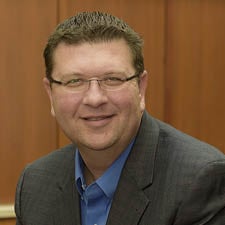As a medical student, do you ever wonder what it’s like to specialize in family medicine? Meet Kevin Hopkins, MD, a family physician and a featured doctor in the AMA’s “Shadow Me” Specialty Series, which offers advice directly from physicians about life in their specialties. Check out his insights to help determine whether a career in family medicine might be a good fit for you.
The AMA’s Specialty Guide simplifies medical students’ specialty selection process, highlight major specialties, detail training information, and provide access to related association information. It is produced by FREIDA™, the AMA Residency & Fellowship Database®.
“Shadowing” Dr. Hopkins
Specialty: Family medicine.
Practice setting: Large multispecialty group practice.
Employment type: Employed physician.
Years in practice: 17.
A typical day and week in my practice: I have a position split between direct patient care and my administrative role. My current leadership position within our organization is as primary care medical director for our Population Health Institute. I have operational oversight for 160–180 primary care providers and their teams across 25 practice locations.
I see patients two days a week and provide care for a panel which is shared between me as the primary care provider and my nurse practitioner partner. Monday, Wednesday and Friday are administrative days filled with meetings. I see patients all day on Tuesdays and Fridays as well as one weekday evening per week and one Saturday morning per month. I am typically at work about 50 hours per week, but the truth is I’m never really “off” unless I’m away on vacation.
The most challenging and rewarding aspects of family medicine: I treasure the relationships built with patients over nearly two decades. The magic of the patient-physician relationship happens within the exam room but increasingly over the phone, through the electronic medical record patient portal, and in virtual space.
People will tell their primary care physician things they won’t say to anyone else. The intimacy of the relationship is an honor and privilege as well as a responsibility I hold sacred. It’s such a pleasure, as a family physician, to take care of multiple generations of a family. There’s great fulfillment in those relationships and the trust implicit in them.
I would say the work of a primary care physician has changed significantly over the past decade or more—and not entirely for the better. Technology and data reporting allow us to care for individuals and groups of patients in ways we never really could before—leveraging objective information rather than just what our gut tells us.
The requirements of documentation, additional regulatory responsibilities, and the sometimes-unrealistic expectations of patients, payers and health systems has made this a time of unique challenges in the business of health care. I remain optimistic that our best days as primary care physicians remain ahead of us.
Three adjectives to describe the typical family physician:
- Personable: Most family docs are pretty nice people.
- Flexible: Things can take a dramatic turn quickly.
- Good communicator: Primary care requires patient and family engagement and building this takes patience and effective multidirectional communication.
How my lifestyle matches, or differs from, what I had envisioned: Pretty closely. I chose family medicine as a career for multiple reasons, lifestyle being one of them. I work a fairly regular, defined schedule. I don’t do inpatient hospital work and I don’t miss it. I don’t have to get out of bed and go to the hospital in the middle of the night and when I am on call, the volume is typically very light and relatively simple. I earn a great living and am able to have some flexibility and autonomy to protect time with my family and have a life outside of medicine.
Skills every physician in training should have for family medicine but won’t be tested for on the board exam: I think family physicians need to be good multitaskers, be all right with being pulled in multiple directions at the same time and be comfortable with uncertainty. People who absolutely must have concrete clarity in all circumstances may struggle in this field. The science of medicine is critical, and often the art of medicine becomes more important depending on the situation. There is a lot of gray area in primary care and physicians in training will need to be tolerant and even energized by this fact.
The online resource students interested in family medicine should follow: I use UpToDate very frequently as an easy to access, point-of-care wealth of information. I enjoy the patient education documents as well as the quality charts, graphs and photos available.




